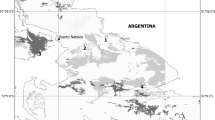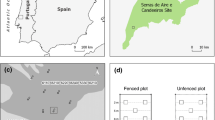Abstract
We investigated species composition and characteristics of plant communities in plots at seven site types within a ski resort: forests, an abandoned ski slope, an area under the gondola lines, forest waterfronts, open waterfronts, edges of ski slopes, and an active ski slope. On the abandoned ski slope, under the gondola lines, at the edges of ski slopes, and on the ski slope, canopy closure was low, tall herbs were present, and species diversity was high. Some wetland species were present at waterfront plots. Differential species composition was caused by vegetation cutting, which was necessary to manage the ski resort. We found various plants, including herbs, some rarely seen because their habitats have decreased. Despite their negative effects, such as surface-soil erosion and magnification of plant size due to the use of ammonium sulfate, ski resorts can be important plant habitats with highly diverse species composition.


Similar content being viewed by others
References
Bayfield NG (1980) Replacement of vegetation on disturbed ground near ski lifts in the Cairngorm Mountains, Scotland. J Biogeogr 7:249–260
Braun-Blanquet J (1964) Pflanzensoziologie: Grundzüge der Vegetationskunde, 3rd edn. Springer, Vienna, p 865
Department of statistics information, the Ministry of Agriculture, Forestry and Fisheries of Japan (2000) World senses of agriculture and forestry in 2000. Norin-Tokei-kyoukai, Tokyo (in Japanese)
Fujii S (1999) A comparative analysis of habitat types of locally endangered plants in Japan. Jpn J Conserv Ecol 4:57–69 (in Japanese with English abstract)
Geographical Survey Institute, Japan (2000) http://www1.gsi.go.jp/geowww/lake/shicchimenseki2.html
Hayashi H, Tominaga T (2004) Effects of mowing on levee flora. The scientific reports of Kyoto Prefectural University. Hum Environ Agric 59:109–113 (in Japanese)
Kadono Y, Yuma M (1995) Nature of wetland. Hoikusya, Osaka, p 198 (in Japanese)
Kim S (1985) Sekundärwiesen. In: Miyawaki A (ed) Vegetation of Japan: Chubu. Shibundo, Tokyo, pp 176–192 (in Japanese)
Kira T (1949) Forest zone in Japan. Forestry explanation series 17. Nippon-Ringyo-Gijutsu-Kyokai, Tokyo (in Japanese)
Koyama Y, Koyama K (2002) Vegetation change for 20-year period at abandoned ski slopes in northern Nagano Prefecture, central Japan. Bulletin of the Institute of Nature Education in Shiga Heights, Shinshu University 39:1–6 (in Japanese and English summary)
Kurihara M, Iuchi M, Furuya K (2001) A study on the succession and the preservation technique on secondary grassland in Kirigamine. Extra Papers on environmental information science 15:215–220 (in Japanese and English abstract)
Meteorological Bureau, Japan (2000) Meshed meteorological data. Meteorological Bureau, Japan
Miyawaki A (ed) (1985) Vegetation of Japan: Chubu. Shibundo, Tokyo (in Japanese)
Miyawaki A, Okuda S, Fujiwara R (1994) Handbook of Japanese vegetation (new revised edition). Shibundo, Tokyo, p 910 (in Japanese)
Murakami Y (1985) Wegrand- und Wald-Saumgesellschaften. In: Miyawaki A (ed) Vegetation of Japan: Chubu. Shibundo, Tokyo, pp 213–219 (in Japanese)
Nagano Nature Conservation Research Institute (2002) Red data book of plants in Nagano Prefecture. Environment and Nature Conservation Section, Life Environment Department, Nagano, pp 297 (in Japanese)
Nagano Nature Conservation Research Institute (2005) Red data book of plants in Nagano Prefecture—Non tracheophyta species and plant communities. Environment and Nature Conservation Section, Life Environment Department, Nagano, pp 205 (in Japanese)
Nakamura T (1988) Phytosociological study on the vegetation at Skiing grounds in Japan. Memoirs of Institute of Agriculture and Forestry, the University of Tsukuba. Agric For Sci 4:1–142 (in Japanese with English summary)
Nakamura T, Tatemoto Y, Kamijo T (1999) Effects of ammonium sulfate on vegetation on ski runs subjected to differing degrees of landscaping. Veg Sci 16:141–147 (in Japanese with English abstract)
Nihon-Ringyo-Chosakai (2002) Data book of forests and timbers 2002. Nihon-Ringyo-Chosakai, Tokyo, p 111 (in Japanese)
Nozaki R (2007) Natural history of summer-green oak (Quercus) forest with special reference to the nature conservation of seminatural vegetation of Japan. Bull Kansai Organ Nat Conserv 29:127–142
Ohkuro T, Shirato Y, Itoh K (2003) Environmental characteristics of abandoned paddy fields contribution to the persistence of the population of a threatened plant species Penthorum chinense. J Jpn Inst Landsc Arch 66:599–602
Ohno K (1985) Bachrinnenwälder in der mountanen Stufe. In: Miyawaki A (ed) Vegetation of Japan: Chubu. Shibundo, Tokyo, pp 256–262 (in Japanese)
Okuda S (1985) Auenwiesen-Gesellschaften. In: Miyawaki A (ed) Vegetation of Japan: Chubu. Shibundo, Tokyo, pp 159–171 (in Japanese)
Raunkiaer C (1934) The life forms of plants and statistical plant geography. The Clarendon Press, Oxford
Sasaki M (2001) Distribution of breeding colonies of herons and egrets and their protection in Kyoto Prefecture. Strix 19:149–160 (in Japanese with English abstract)
Satake Y, Hara H, Watari S, Tominari T (1989a) Wild flowers of Japan. Woody plants I. Heibonsha, Tokyo, p 321 (In Japanese)
Satake Y, Hara H, Watari S, Tominari T (1989b) Wild flowers of Japan. Woody plants II. Heibonsha, Tokyo, p 305 (In Japanese)
Serizawa S (1995) Nature in country town. Hoikusha, Osaka, p 196 (In Japanese)
Shimano K (2006) Differences in beech (Fagus crenata) regeneration between two types of Japanese beech forest and along snow gradient. Ecol Res 21:651–663
Shimano K, Yatake H, Nashimoto M, Shiraki S, Matsuki R (2006) Habitat availability and density estimations for the Japanese hare by fecal pellet counting. J Wildl Manage 70:1651–1658
Shimazaki Y (1999) I will undertake silvicultural management. Kawabe-Shorin, Nagano (in Japanese. The title was temporally translated by the authors)
Shimoda M (1996) Abandoned rice field vegetation and its evaluation: a case study of wet abandoned rice field vegetation in Hiroshima prefecture. Veg Sci 13:37–50 (in Japanese and English abstract)
Shimoda M, Suzuki H (1981) Vegetation of fallow rice fields in the Saijo Basin, Hiroshima Prefecture, Japan. Hikobia Suppl 1:321–339 (in Japanese with English summary)
Suga T (2008) Historical change of semi-natural grasslands in the central mountainous area of Japan and their implications for conservation of grassland species. Bull Nagano Environ Conserv Res Inst 4:17–31 (in Japanese with English abstract)
Suzuki S (1985) Nadelholz-reiche Sekundärwälder. In: Miyawaki A (ed) Vegetation of Japan: Chubu. Shibundo, Tokyo, pp 176–192 (in Japanese)
Tabata H (1997) Nature of country areas. Hoikusha, Osaka, p 199 (in Japanese)
Tatemoto Y, Nakamura T (1999) The actual situation of using ammonium sulfate in skiing areas. Jpn Outdoor Edu J 2:13–19 (in Japanese and English summary)
Watanabe R (1999) Development of ski resort and nature conservation in Nagano. Jpn J Ecol 49:277–281 (in Japanese)
Watson A (1985) Soil erosion and vegetation damage near ski lifts at Cairn Gorm. Scotland Biol Conserv 33:363–381
Yamamoto K (2004) http://www.agr.nagoya-u.ac.jp/~shinkan/LIA32/index-e.html
Yokouchi F (1979) Pinus densiflora forst. Vegetation of Nagano Prefecture. In: Arbeitsgemeinschaft für die Vegetationskartierung der Präfektur Nagano. Reale Vegetation der Präfektur Nagano: Eine pflanzensoziologishe Studie für den Natur—und Umweltschutz, sowie die Schaffung eines vegetationsreichen Landes der Präfektur Nagano, Präfektur Nagano, pp 287–288 (in Japanese with German summary)
Acknowledgments
Mr. K. Takeuchi and Mr. T. Hatanaka of Shinshu University assisted greatly with our field survey. Fujimi Panorama Resort Company and its members also provided support. Dr. Akira Hiruma, a curator of Iida City Museum, offered helpful suggestions on constructing a synthetic table. We appreciate their help very much.
Author information
Authors and Affiliations
Corresponding author
Rights and permissions
About this article
Cite this article
Kubota, H., Shimano, K. Effects of ski resort management on vegetation. Landscape Ecol Eng 6, 61–74 (2010). https://doi.org/10.1007/s11355-009-0085-4
Received:
Revised:
Accepted:
Published:
Issue Date:
DOI: https://doi.org/10.1007/s11355-009-0085-4




